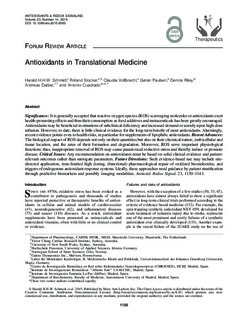| dc.contributor.author | Schmidt, Harald | |
| dc.contributor.author | Stocker, Roland | |
| dc.contributor.author | Vollbracht, Claudia | |
| dc.contributor.author | Paulsen, Gøran | |
| dc.contributor.author | Riley, Dennis | |
| dc.contributor.author | Daiber, Andreas | |
| dc.contributor.author | Cuadrado, Antonio | |
| dc.date.accessioned | 2016-05-25T09:43:59Z | |
| dc.date.available | 2016-05-25T09:43:59Z | |
| dc.date.issued | 2015-08-31 | |
| dc.identifier.citation | Antioxidants and Redox Signaling. 2015, 23, 1130-1143 | nb_NO |
| dc.identifier.uri | http://hdl.handle.net/11250/2390312 | |
| dc.description | © Harald H.H.W. Schmidt et al. 2015; Published by Mary Ann Liebert, Inc. This Open Access article is distributed under the terms of the Creative Commons Attribution Noncommercial License (http://creativecommons.org/licenses/by-nc/4.0/) which permits any noncommercial use, distribution, and reproduction in any medium, provided the original author(s) and the source are credited. | nb_NO |
| dc.description.abstract | Significance: It is generally accepted that reactive oxygen species (ROS) scavenging molecules or antioxidants exert health-promoting effects and thus their consumption as food additives and nutraceuticals has been greatly encouraged. Antioxidants may be beneficial in situations of subclinical deficiency and increased demand or acutely upon high-dose infusion. However, to date, there is little clinical evidence for the long-term benefit of most antioxidants. Alarmingly, recent evidence points even to health risks, in particular for supplements of lipophilic antioxidants. Recent Advances: The biological impact of ROS depends not only on their quantities but also on their chemical nature, (sub)cellular and tissue location, and the rates of their formation and degradation. Moreover, ROS serve important physiological functions; thus, inappropriate removal of ROS may cause paradoxical reductive stress and thereby induce or promote disease. Critical Issues: Any recommendation on antioxidants must be based on solid clinical evidence and patient-relevant outcomes rather than surrogate parameters. Future Directions: Such evidence-based use may include site-directed application, time-limited high dosing, (functional) pharmacological repair of oxidized biomolecules, and triggers of endogenous antioxidant response systems. Ideally, these approaches need guidance by patient stratification through predictive biomarkers and possibly imaging modalities. Antioxid. Redox Signal. 23, 1130–1143. | nb_NO |
| dc.language.iso | eng | nb_NO |
| dc.publisher | Mary Ann Liebert, Inc. | nb_NO |
| dc.title | Antioxidants in Translational Medicine | nb_NO |
| dc.type | Journal article | nb_NO |
| dc.type | Peer reviewed | nb_NO |
| dc.subject.nsi | VDP::Mathematics and natural science: 400 | nb_NO |
| dc.subject.nsi | VDP::Mathematics and natural science: 400::Basic biosciences: 470 | nb_NO |
| dc.source.journal | Antioxidants and Redox Signaling | nb_NO |
| dc.description.localcode | Seksjon for fysisk prestasjonsevne / Department of Physical Performance | nb_NO |
